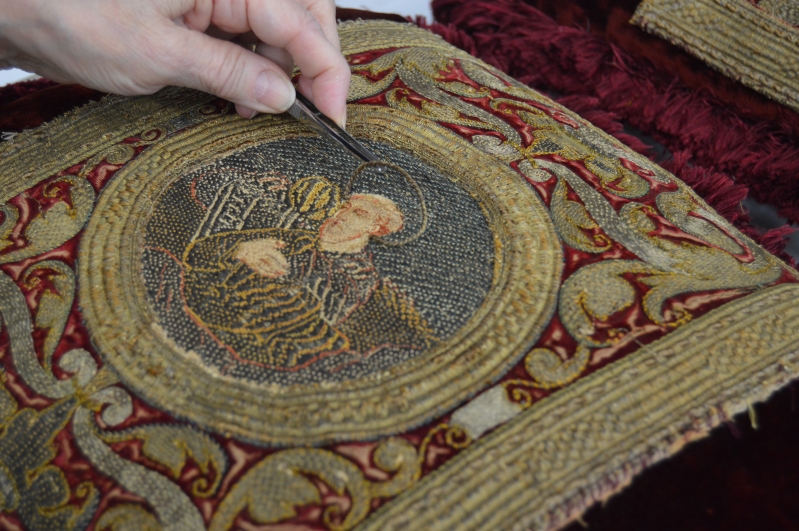Meet the Staff

The Textile Conservation Laboratory was the vision of Barbara Bonner, who was hired in 1980 as director and curator for what was then the Cathedral musuem. As she oversaw the conservation of the Cathedral's extensive art holdings, Bonner realized the tapestries, in particular, needed a great deal of work. She enlisted the help of Adolfo Cavallo, a curator who had worked with tapestry collections at the Philadelphia Museum of Art, the Isabella Stewart Gardner Museum and the Boston Museum of Fine Arts, and who had published an article on the Barberini series The Life of Pope Urban VIII. With Cavallo's help and the advice of curartors at the Metropolitan Museum, Soccarides secured funding for the new phase of conservation that was to begin in 1982. Cavallo succeeded Bonner as director of the Cathedral museum.
The first director of what was now called the Textile Conservation Lab, R. Bruce Hutchinson, was hired in 1982. Under his leadership, the Lab was equipped with an electric hoist system, a suction table and dye laboratory, all with the help of grants from the National Endowment for the Arts, J. P. Getty Grants Program, the Samuel Kress Foundation and the Municipal Arts Council. Throughout the 1980's, the Lab gained prominence as museums such as the Metroplitan Museum of Art, the Newark Museum, the Cincinnati Museum of Art, the J. Paul Getty Museum, the Winnipeg Art Gallery, the Detroit Institute of the Arts, the Philadelphia Museum of Art and the Wadsworth Athenaeum entrusted it with the conservation treatments of valuable works. As the field of textile conservation grew, Mr. Hutchinson ensured that the Lab would be at the forefront of national and international development by participating in research and publications that set the standards for tapestry and textile conservation.
The current Director, Marlene Eidelheit, has been in charge since 1992. The variety of Lab projects has grown, as conservators continue to gain experience with unique objects and apply new techniques in textile conservation. A significant loss occured in the 2001 six-alarm fire in the Cathedral that severly damaged two of the Barberini tapestries (The Last Supper and The Resurrection) so that only large fragments of them now remain. Four others were affected by smoke and have been carefully conserved. The tapestries are now in the best shape they have been in since the Cathedral acquired them.
Each piece that is brought to the Lab is analyzed for its conservation needs, including research into the inconography and and history of the textile to ensure accuracy. Unlike restorers, who seek to make an object like new, the goal of the Textile Conservation Lab is to keep the condition of the object from getting worse. One of the most important steps in the treatment is cleaning. The piece may be wet cleaned in deionized water with a mild detergent, cleaned with a low-suction vacuum, or spot-cleaned with solvent solutions. Dental probes and tweezers are used to loosen the thickest layers of soiling. Then weak areas, splits, and missing fibers are stabilized by hand, with needle and color-matched thread dyed on site. Decaying silk is reinforced with spaced tabby weaved specially treated to shimmer like the original fiber. Finally, backings, mounts or frames are created to display the work. This can require creative thinking, as evidenced in a recent project where the client wanted the textile to cover a ceiling. Hundreds of tiny magnets were needed to combat gravity and prevent sags, folds or bunching.
In addition to Ms. Eidelheit and a full contingent of six Conservators, the Lab accepts qualified interns who possess technical skill, understanding of conservation practices, and desire to contibute to the field of art conservation. Many former employees have gone on to head conservation labs around the world, and interns frequently move on to museum positions.